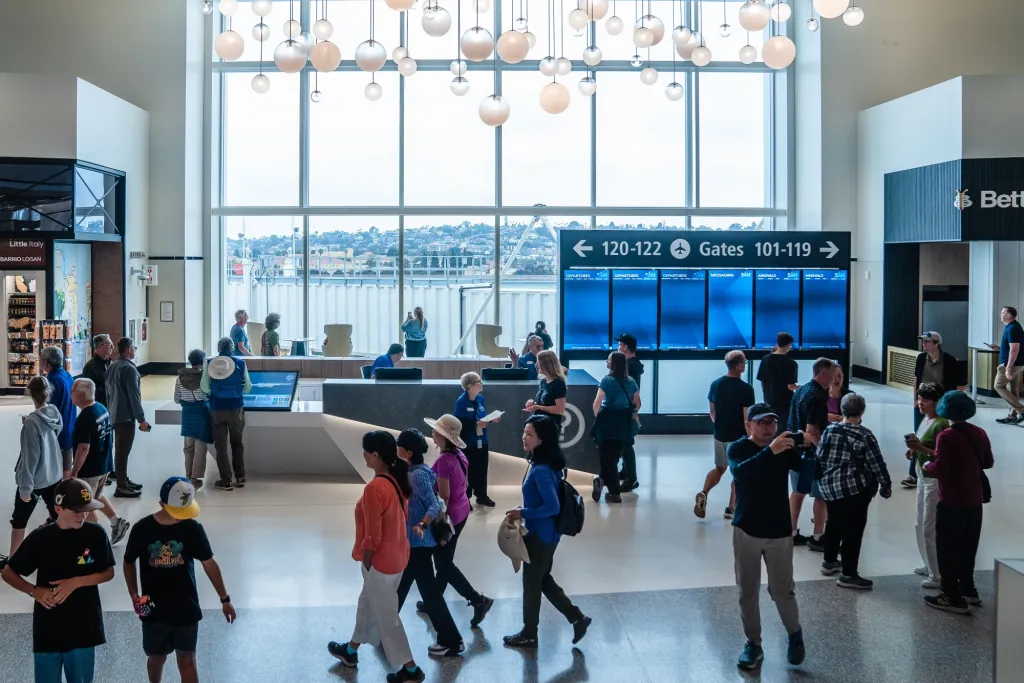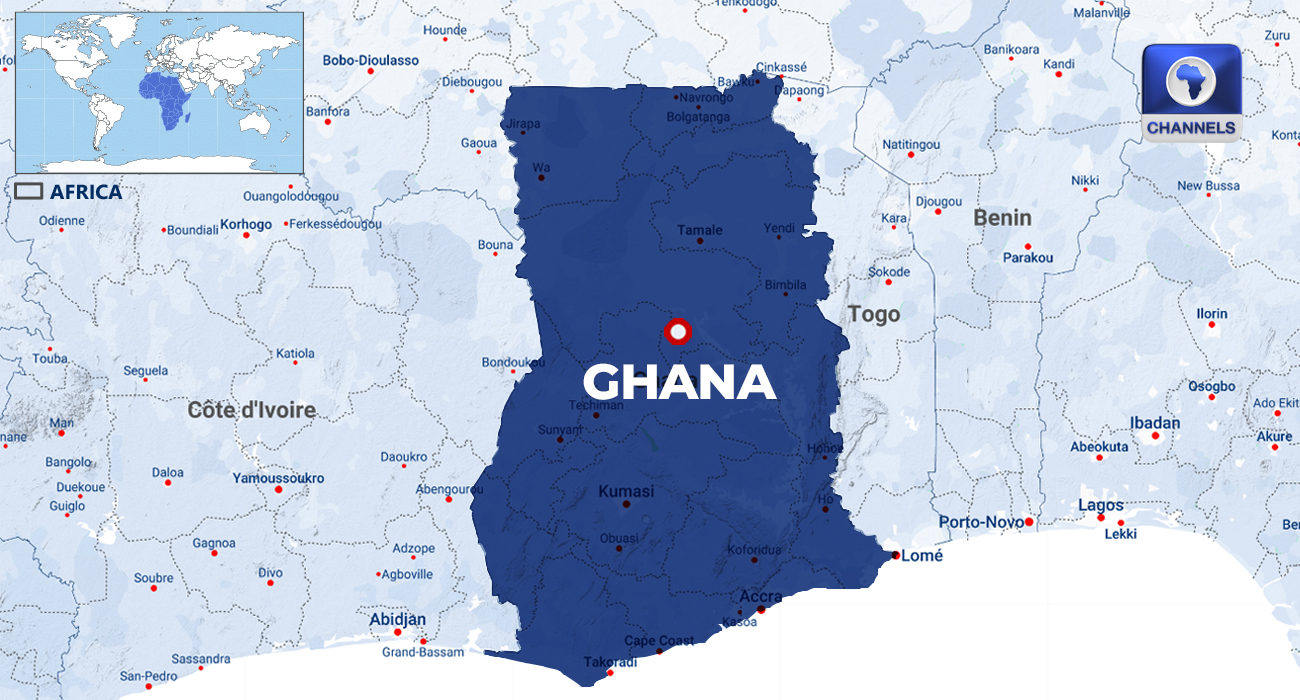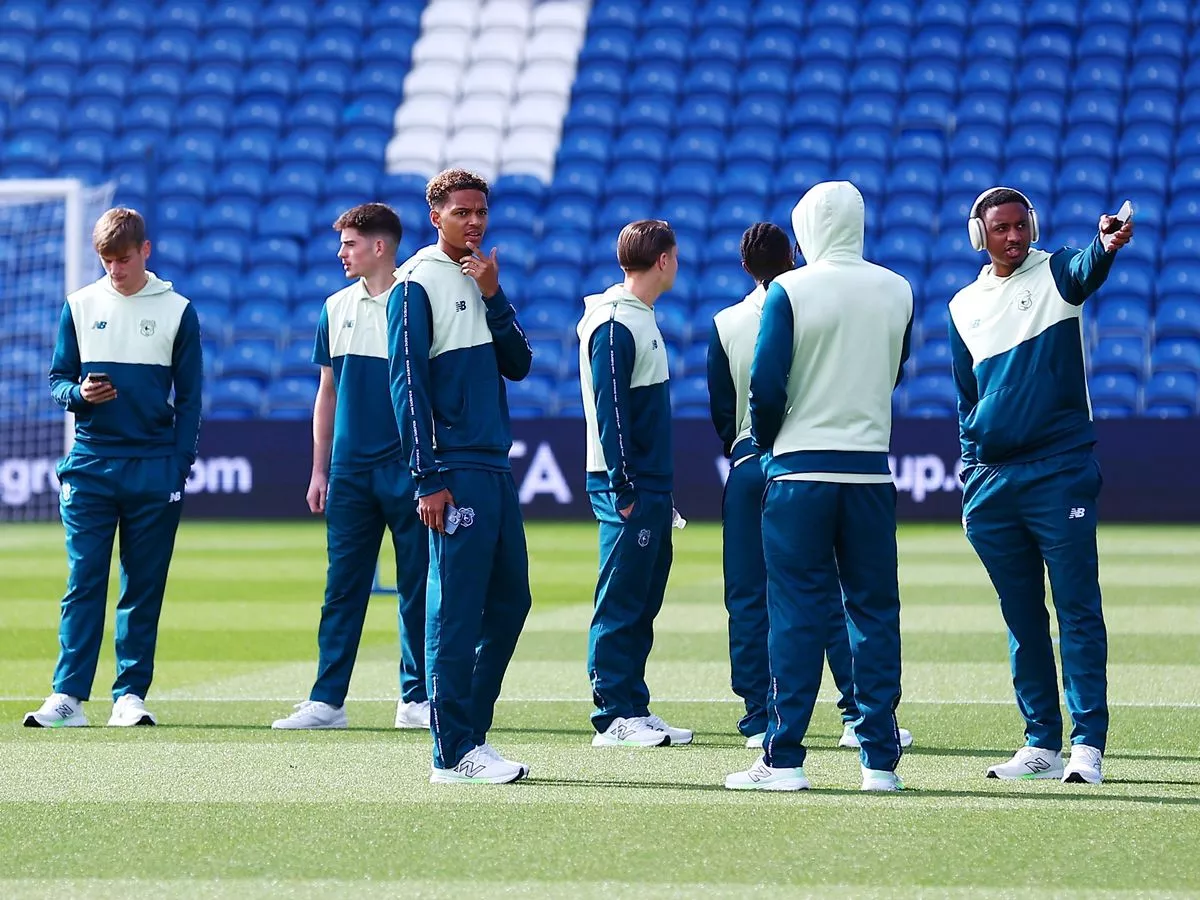
For decades, local leaders vainly searched for a new location for San Diego’s international airport, which has but a single runway and is hemmed in by the bay and dense urban neighborhoods, with no room to grow.
When the quixotic quest finally ended in 2006 with the lopsided failure of a ballot measure to move the airfield and its terminals to Miramar Marine Corps Air Station, the airport did the next best thing. It went into full-on redevelopment mode, beginning with a nearly $1 billion makeover of Terminal 2 that included 10 more gates.
A little more than a decade later, the airport’s redevelopment pivot will culminate this month with the first phase opening of a gleaming, light-filled new Terminal 1 that will eventually house 30 gates and eight airlines. By the time the final phase of the 1.2 million-square-foot building is complete in early 2028, the total cost between the two expansion projects will approach $5 billion.
Multibillion-dollar investments in aging airport terminals across the country have become increasingly common amid a surge in travel that began well before COVID-19 and has rebounded sharply since the waning days of the pandemic.
The existing Terminal 1 that San Diego’s new facility is replacing is one-third the size of the new building and more than a half-century old, years past its useful life. It soon will be demolished, but the single runway will remain — along with the inevitable growth limitations that come with that.
“One thing we like to remind people of is that the limiter of capacity at the airport is not gates, it is not square footage,” said Matt Harris, director of governmental relations and strategy for the San Diego County Regional Airport Authority, during a recent presentation to local elected leaders. “It is the runway and we have one of those, and we have no plans or ability to create a new one. Our one runway dictates the number of flights that can keep coming in and out.”
Given that the more than 660-acre airport doesn’t have sufficient real estate to expand, the airport had to engage in an exercise of musical chairs to make room for the Terminal 1 project. Among the buildings that had to be removed were the Airport Authority’s former administration building and an old United Airlines hangar.
Technically, Terminal 1 isn’t likely to reach its operational capacity until about two decades from now, when roughly 20 million passengers — compared with last year’s 10 million — are forecast to be flying in and out of the facility over the course of a year. In the meantime, airport officials want to spread the word that the long wait for a far more comfortable and enjoyable, 21st-century flying experience is finally over.
Designer restrooms featuring shimmering blue mosaic tile and marble-like finishes, an outdoor dining area with downtown skyline views, new foodie-friendly concessions and a vast ticketing hall with dozens of check-in kiosks are among the many features likely to wow passengers accustomed to the existing Terminal 1, say airport officials.
“We’re using a building in a setup that wasn’t designed to handle the throughput that the airport has today and that it’s projected to have into the 2040s,” said Gil Cabrera, who chairs the Airport Authority board of directors. “That’s what the purpose of this whole project is. You’re going to be blown away by just how it looks and how much roomier it feels. I don’t know about you, but I feel so constrained when I’m in Terminal 1 now. You just feel like there are bodies everywhere. And it’ll be a whole different vibe in Terminal 1 because the ceilings are taller and just about everything feels bigger and wider.
“The other thing is, it’s no longer these two circles (rotundas) with the gates. It’s linear, so you’re no longer on top of each other. Another biggie is that right now, there are two checkpoints kind of shoved into a very, very narrow space in Terminal 1. In the new terminal there’s just one; that means you’re never going to have go through the wrong checkpoint again.”
What does Southwest Airlines think?
There’s much to love about the new building, but what tops everything, says Southwest Airlines Chief Operating Officer Andrew Watterson, is the expanded number of gates.
The airline, which is San Diego’s single biggest carrier in terms of flight volume, still has not returned to pre-pandemic flight levels because of the more than three-year shutdown of five of the 19 gates in the old terminal due to construction activity. Come October, when Southwest releases its new schedule, there will be seven new nonstops, from Colorado Springs to Tampa. And passengers can expect, over time, still more flights once Terminal 1 grows to 30 gates in 2028, Watterson says.
“The current terminal was built for an era where there were a lot fewer passengers, the planes were smaller, there wasn’t such intensive security, and you didn’t spend as much time at the airport,” he said during an interview at the old Terminal 1 as the loudspeaker blared passenger alerts. “The feedback from our customers in San Diego starts from the curb — the curbside is very congested. TSA is undersized, the gate rooms are undersized, and the concession options are limited.
“Overall, it’s probably on the lower end of our customer experience all around the system. But starting with our October schedule and then into our March schedule, we’ll be back to our pre-pandemic highs, and after that, we will then have a chance to expand even more. And because there will be more gates, we will be able to also schedule longer flights, because longer flights mean you have to spend more time at the gate.”
While San Diego’s single runway is an obvious barrier to adding more flights in general, it’s not the primary one for Southwest, says Watterson. The two biggest improvements for the airline — and by extension, the passengers — are the additional gates and what eventually will be a second taxiway, he said.
“Runways are a common problem for the United States,” Watterson said. “There are very few airports that actually don’t have this issue, even airports with two runways or three runways. Right now, a lot of the focus is on air traffic control, and rightly so. But once you solve the air traffic control issue, just behind it is the runway capacity. The United States is not creating runways fast enough compared to overall air travel demand. It’s not just a San Diego problem, but a national problem.”
Who pays for the new terminal?
Runways aside, airport terminal projects are extremely pricey, whether it’s Kansas City, LaGuardia or Dallas, which have undertaken major modernization efforts over the past several years. In San Diego, all that extra space, not to mention passenger-friendly amenities like a high-tech baggage handling system and plenty of eye-catching public art, comes with a hefty cost. What started out as a $3 billion budget later grew to $3.8 billion, for a variety of reasons.
Airport Authority Chief Financial Officer Scott Brickner explained that the initial $3 billion figure was an estimate that predated the hiring of a contractor and designers who later refined the cost to $3.4 billion in 2021.
“Subsequently, in January 2024, we increased the budget by $370 million due to cost escalation coming out of COVID,” Brickner explained. “But it was actually a good story because when I talked to all my colleagues at the time, they were seeing 20, 30, 40% increases in their budgets for their capital programs, whereas ours was just under an 11% increase.
“Nobody was happy about it, but it could have been much worse. And making that decision during COVID to proceed with the project allowed us to get a lot of the work under contract and started before all those hyperinflationary effects would impact us.”
Financing of the project comes largely from the airlines in the form of the terminal rent they pay to the airport, in addition to landing fees and aircraft parking, Brickner said. There’s also a host of non-airline revenue sources such as parking, concessions, and ground transportation and rental car concession fees.
While in years past, airlines frequently have balked at helping finance a good share of the cost, that wasn’t the case in San Diego, which has been talking about and planning for a new Terminal 1 for more than a decade.
“You read about problems between airlines and airports and financing, and it’s because it’s not a collaborative approach,” said Watterson. “San Diego took a very collaborative approach to building the terminal, so the airlines were literally on board from the beginning. As a result, it was very smooth, as far as the agreement between the airlines in the airport, and also very fast, because I can’t overstate how difficult it is to build a new terminal while you’re operating one right nearby. This is a very difficult situation the airport managed well.”
Travel industry analyst Henry Harteveldt said he’s impressed by not only what he says is the speedy completion of the project but the willingness of the airlines to finance it.
“You have to understand that the only thing that moves quickly at an airport are the airplanes,” said Harteveldt, founder of Atmosphere Research Group. “Everything else takes forever because airports are not like typical construction projects. In the case of terminals, they have to be designed, not only to serve the passengers and the planes, but to meet very stringent journey and safety standards.
“And airlines obviously don’t like paying more for anything anywhere, so the fact that the airport got the airlines on board is an enormous accomplishment.”
Beyond the airlines, yet another component of funding comes from the air travelers themselves. Each passenger pays a facility charge of $4.50 that’s collected by the airlines and later remitted back to the Airport Authority.
“It’s not a tax, it’s a user fee,” Brickner said. “If you don’t use the airport, you don’t pay for it. If you do use the airport, depending on what services you use, you do pay for it.”
Brickner said that from the beginning it was assumed there would only be a federal contribution of $80 million. Instead, the agency ended up getting more than $300 million from the federal government.
What does $3.8 billion buy you?
Much has been made of the designer restrooms, the upper-level patio dining venue, and locally based dining and drinking concessions that include such familiar names as The Taco Stand, Ambrogio 15 and Cutwater. But bottom line, everything at the new terminal is simply more spacious.
Airline passengers are likely to be especially thankful for a roomier security screening area that will initially have 13 lanes compared with the 10 in the existing terminal. Given the area’s larger footprint, it will be less likely to have the bottlenecks commonly found in the narrower screening area in the old facility.
Also far more spacious is the baggage claim area, which, in the first phase, will have seven carousels — more than twice the current number. It’s also expected to be a more efficient and speedier system, thanks to a basement-level, 4-mile-long baggage belt that will be able to handle higher volumes of luggage.
Abundant seating, including rocking chairs, can be found at each of the gates, and every other seat is powered for electronic devices. Pops of color and custom artwork are everywhere, from the exterior entrances to the restrooms and mosaic-clad columns past the security area to the imposing gold-finished art piece suspended from the ceiling, which is meant to represent three Torrey pine trees.
The overall project, though, is much more than a new modern terminal. Part of the reason for the significant federal investment is the considerable airfield work that is being undertaken, most notably a second taxiway intended to ease congestion for planes awaiting takeoff and others making their way to gates upon arrival at the airport. While it’s not akin to a second runway, it should make takeoffs and arrivals, especially during peak periods, much more efficient.
About 70% of the taxiway already has been constructed and is currently in operation. The remaining 30% will be built during the second phase of the terminal project, with completion expected by August 2028.
“To get to the runway right now, there’s just a one-lane road where you can only move in one direction at a time,” Cabrera explained. “And if there are any airplanes that need to come back or need to move to another spot, the traffic going to the runway has to wait to go around them. This new taxiway will allow for two-way traffic onto and from the runway.
“This just makes that sort of ballet of airplanes on the airfield more efficient, and it should improve some of the timing in terms of both your pushback timing and your getting to the gate.”
Another game-changer for the airport — and one that’s already up and running — is the new three-lane, on-airport roadway that entirely bypasses North Harbor Drive and delivers motorists to Terminals 1 and 2, as well as the parking garages. The net effect is the removal of 45,000 cars a day from the once-congested North Harbor Drive, which now feels almost empty at certain times of the day compared to before the roadway opened.
The project also calls for several improvements to high-volume roadways that will increase lanes and add traffic signals and signage on Palm Street; upgrade streetlights and increase traffic signage for Pacific Highway intersections at West Laurel, Palm, Sassafras and Washington streets; and add lanes on Grape Street.
But what about public transit?
It was 2018, and plans to replace the cramped Terminal 1 were advancing rapidly, with construction expected to start in 2020. But all of a sudden, that forward momentum appeared to be in real jeopardy. Government agencies across the county, from the city of San Diego to the Port of San Diego and Metropolitan Transit System were universal in their withering criticism.
The project’s environmental consequences — most notably, increased traffic congestion — had largely been ignored, and planning for future transit to the airport was absent, they claimed.
Airport officials ultimately took the criticism to heart, and what ensued were a series of meetings with stakeholders to come up with a more precise strategy for delivering a direct transit connection to the airport, be it an elevated people mover or trolley extension or simply improved bus service.
The Airport Authority agreed to rewrite the already completed draft environmental impact report, which had the effect of delaying the project by about a year. The net effect, though, of the new analysis was a slightly smaller parking garage — 2,000 spaces were removed — which in turn allowed the airport to set aside space between Terminals 1 and 2 for a future transit station.
On top of that, the Airport Authority secured an agreement from the airlines to contribute $350 million toward a future transit link.
In the years since, transportation planners with the San Diego Association of Governments have spent considerable time researching and refining a transit strategy, although progress came in fits and starts as SANDAG underwent leadership changes.
During a recent update provided by SANDAG, Marissa Mangen, project manager for the airport transit connection project, said that the planning agency is in the final stages of whittling down multiple options and routes for an automated people mover or alternatively, a trolley extension. Once that is completed, an environmental review would follow.
Funding, though, for such an ambitious project, which could approach $2 billion, remains elusive for now. In the short term, Mangen said, the agency will continue to focus on more immediate solutions like improving bus service.
“At this point, I think it’s more of a hope than a faith in it, to be honest with you,” Cabrera said of airport mass transit. “I would love to have a connection, but it’s going to take a concerted effort from all three levels of government to actually make it happen, just because of how expensive it’ll be, and right now, you don’t have a transit-friendly federal government, and the state is having budget issues.
“I’m concerned about it happening anytime soon, but I’m hopeful it will happen at some point in the future.”



